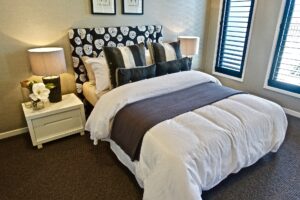When talking about bed, the first thing that comes to mind is a peaceful sleep. What bedding material is best for restful sleep? There are countless gadgets available in the market that are essential for a comfortable sleep in your bed. The role of our bed is very important for our best sleep. Experts in this business know exactly what qualities are essential for a good night’s sleep. The same features in a standard bed affect the price of that bed.
Before you start with the luxurious bed linens and accessories, think about the foundations of your bed. Duvet construction and covering are two other factors that are important to consider. Packing and cocoon walls( walls of fabric which produce separate chambers in the duvet) are the stylish way to retain the duvet shape and heat whilst “ a high-quality, down-proof covering will ameliorate the weight and handle( feel) of the duvet. ”

Pillows should be soft enough to be comfortable but firm enough to give the applicable support to your head, neck, and shoulders. A test to know if it’s time to replace your pillow is to place it over your arm if it droops, it’s time for a new bone
Importance of duvet
A duvet insert usually consists of plain cotton, polyester, or cotton/polyester blend filling enclosed in a shell. While some owners may choose to use an insert alone, duvet inserts are designed to be paired with a duvet cover for easy cleaning and more styling options. Covering materials can include cotton, flannel, silk, linen, and even faux fur. These covers are usually fastened to the insert with ties, buttons, or zippers to prevent transfer.
While you may find some duvet inserts washable, many have special care instructions to prevent damage. Duvet covers, on the other hand, are usually machine washable. Duvet inserts vary in price points it depends on their quality & their materials. Covers can also add to the overall cost, especially if you want several options to change the look and feel of your bed.
What is linen?
Linen is a material crafted from the flax plant, one of the maximum sustainable materials inside the world. Flax is cultivated all through the sector and might develop in any environment. However, superb linen comes from Belgium, France, and the Netherlands as their weather is fine and suitable for flax. The manner to make linen is one wherein they separate the lengthy fibers from the fast fibers because the lengthy fibers are used to make the best linen. (The short-length fibers aren’t discarded, they may be used to make long-lasting materials like canvas.) Once the lengthy fibers are spun into yarn and thoroughly scrutinized for quality, they may be geared up to be made into great linen.
Linen is obtained from the flax plant. For this purpose, the flax plant is grown all over the world, but the linen obtained from Europe is called European bed linens. Similarly, Portugal linens and French linens are preferred in the market while Belgium linen is preferred.
Linen benefits: 
Linen is highly breathable and temperature-regulating, it is very absorbent and dry too. It’s hypoallergenic, antimicrobial & antibacterial naturally. Softer and softer with each wash, durable and easy to maintain.
Linen disadvantages:
Initially thick, thick feeling. Wrinkles easily (but some have such a beautiful textured look). It’s more expensive than cotton.
Silk:
Centuries-old methods are being used to obtain silk. Silk is obtained from a specific type of silkworm. This worm is raised organically. When silk is produced. Then the same silkworm is boiled and killed. Without killing the silkworm, the result in the fabric is hard silk instead of soft.
Silk benefits:
Silk is highly breathable and temperature regulating, anti-wrinkle-strong and lightweight, also luxuriously soft.
Silk disadvantages:
Silk is difficult to care for. It’s not animal-friendly. Suitable only hand wash method. Silk is one of the most expensive fabrics in the world.
Bamboo lyocell:
Bamboo fiber is obtained by crushing bamboo. It is bamboo pulp. After washing, the spunk is converted into yarn, which is called bamboo cloth. The whole process is eco-friendly. Bamboo and linen sheets both have some pros and cons.
Bamboo lyocell benefits:
It’s extremely breathable temperature-regulating, and eco-friendly. Bamboo lyocell is naturally hypoallergenic, antimicrobial & antibacterial, also silky soft, and drapes beautifully.
Disadvantages of bamboo lyocell:
Different kinds of bamboo fiber are on the market, leading to some confusion. The price point compared to cotton is higher. Natural materials might be more delicate and cause initial pilling.
Synthetics:
The most common fibers are polyolefin, nylon, polyester, and acrylic. Synthetic fiber is made of different chemicals and a mixture of many materials. Synthetic fiber sheets are very popular due to their inexpensive cost.
Benefits of synthetic bedding material:
It is more durable and cheaper than natural fiber. It can be stretchy or waterproof depends the chemical process applied.
Disadvantages of synthetic bedding:
Breathability and sturdiness depend upon the weave making them sense hot;
More at risk of pilling and static electricity;
While water-resistant, they could take in oils and grease leading to staining;
Chemicals used can aggravate the pores and skin leading to rashes and itchiness;

